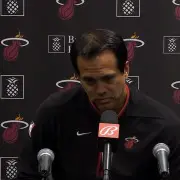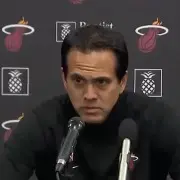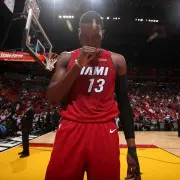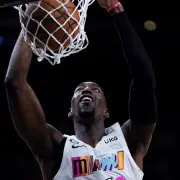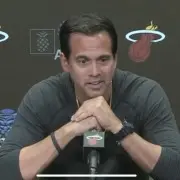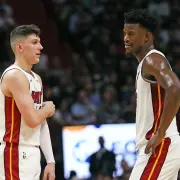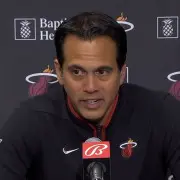Mateo’s Hoop Diary: LeBron James Surpasses Kareem Abdul-Jabbar’s Regular Season Scoring Record
Even before tipoff, supporting and rival fans sat in their seats, powerless to contain their excitement as impending history was moments away. The Thunder, the team LeBron James and the Miami Heat beat in the 2012 Finals for his first of four chips, was in Los Angeles. So were the King’s family and teammates from St. Vincent St. Mary’s High School.
James didn’t get on the scoreboard until his third attempt of the game. He isolated OKC’s Jaylin Williams in the left corner, then hit a step-back 3-pointer. Against the Thunder’s 2-3 zone, LBJ gashed the middle on a rim roll assisted by Russell Westbrook for a four-foot layup.
His second steal of the quarter sparked the break. This time near the rim, he didn’t pass, as he did a minute into the period, losing the ball. He effortlessly spun past Shai Gilgeous-Alexander and Jalen Williams for the soft finish.
Through 12 minutes, James had eight points and two dimes, aside from his pair of steals. Judging by his body language, it seemed as if he made up his mind about doing whatever it took to break the levee. In the second quarter, he logged three out of four field goals and five out of six free throws, putting him at 20 points at the intermission.
As he dribbled up court in transition, he zipped past the nonexistent trailing defense to get to the cup for two more. In the half court, he ran pick and roll with Thomas Bryant, buying him the opening to carve up the paint on a left-handed finish. To stop the bleeding of a 10-0 Thunder run, James maneuvered to the top of the key, hitting a triple as his defender, Kenrich Williams, went under Bryant’s screen.
Despite James’ contributions in the first half, the Lakers were inept in stopping the ball. On innumerable possessions, Los Angeles was late to close out to the perimeter or didn’t try. As a result, the Thunder had converted 12 out of 19 deep shots, pushing them to a 10-point lead, in spite of being outrebounded, having more turnovers and fewer trips to the line.
In the third quarter, James was unrelenting in his pursuit of history. After missing a pull-up jumper on the baseline, he hit his next three shots: two triples and a layup on a four-on-two break.
With 10.9 seconds left in the period, James posted up K. Williams at the nail and hit a fadeaway jumper to snatch the all-time regular season scoring record.
The game stopped momentarily as the King received his flowers; his loved ones embraced him as the Lakers recognized the achievement with a video presentation. Then, at center court, Kareem Abdul-Jabar handed him over the ball, signifying the passing of the torch to the new keeper of the grail.
The game was stopped for James, as it was for Abdul-Jabbar when he hit the milestone with nine minutes left against Utah in Las Vegas on Apr. 5, 1984. Then everyone had to get back to work.
The fourth quarter started with the Lakers down five points. The hosts managed to tie with over nine minutes left, but OKC countered with Isaiah Joe splashing a left-wing triple against man-to-man coverage. Both teams, in turn, would trade buckets scoring 24 points the rest of the way, but the primary issue for the Lakers was guarding and completing possessions. Point-of-attack defenders were going under OKC’s screens, allowing openings inside. The Lakers lost 133-130.
Postgame, coach Darvin Ham committed the cardinal sin- talking too much. He said, “A lot of times, the focus was more about trying to get ‘Bron to the record as opposed to just playing natural basketball…”
I appreciate his honesty. But it’s doubtful his players will be enthused with how candidly Ham spoke.
It wasn’t a fairy tale ending to a historic night. The closing was as grim as The Song of Ice and Fire and all its lore, written by George R.R. Martin. But that shouldn’t discredit James’ accomplishment.
Abdul-Jabbar held on to that mark for two months shy of 39 years. Like Russell Westbrook’s triple-double record that formerly belonged to Oscar Robertson, this milestone seemed impossible to grasp for a long time. When LeBron finished year 17, and there were still no signs of slowing down offensively, surpassing Kareem became inevitable.
Before #33, Wilt Chamberlain, the NBA’s most dominant presence and gifted athlete owned the record for 12 years. Prior to him, it was Bob Pettit for three, and so the list goes on. In the age of load management, the new threshold is probably beyond reach for everyone when James hangs up his sneakers.
The NBA has been around since 1949. Countless trailblazers have left an indelible mark on the league. Out of the thousands of players who have competed on the hardwood, only 10 of them have recorded at least 20 seasons of action. James is one of those guys, and he’s still got so much more to give.
When Kareem passed Wilt, Lakers broadcaster Chick Hearn said, “The new king of scoring has ascended his throne.” It was a long reign. This feat is a testament to the unrivaled skill and longevity of Abdul-Jabar and James.
Compliments aimed at the King’s direction are well deserved. In fairness to him, he eclipsed Abdul-Jabbar in scoring back in February of 2022, when you count playoffs + the regular season for both players.
Following the game, James said reality hadn’t settled in yet. That’s not surprising. Everyone who witnessed the moment on Tuesday night probably feels the same way. After two tours in Cleveland, one with Miami in between those, and his latest in Los Angeles, the book is not finished.
Before leaving the court, James was asked through the TNT headset if he could play two-to-three more years. Confidently, he said he could.
“The way I’m feeling, and the way my body has been reacting throughout the course of the season, I know I can play a couple more years. It’s all about my mind. If my mind is still into it… then I can continue to play this game.”

